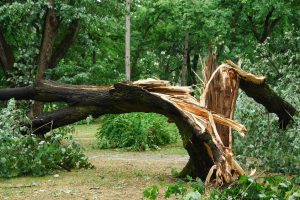How to tell if a tree is going to fall
Trees, while lovely and beneficial to our environment, can pose problems if they become unstable or unhealthy. Identifying the warning indications that a tree is about to fall is critical for preventing property damage, injuries, and even fatalities. In this detailed guide, we’ll look at how to tell if a tree is going to fall, giving you the knowledge about what preventive measures need to be done.
Signs of a Potentially Falling Tree
Identifying warning signals that a tree may be about to fall is critical for maintaining safety and avoiding property damage or accidents. Here are some significant indicators to watch out for:
Leaning: Trees that lean heavily to one side, particularly if the lean has increased over time, may be prone to falling. Leaning trees might signal root problems or structural flaws.
Crack or splits: Visible cracks or fissures in the trunk or large branches indicate structural failure. These flaws might cause the tree to collapse, particularly during heavy winds or storms.
Decay: Rotting or hollow sections in the trunk or large branches can compromise the tree’s structural integrity, increasing the probability of collapse. Fungal infections and insect infestations are common causes of decay.
Dead or Hanging limbs: Dead limbs or those that hang perilously from the tree can fall unexpectedly, creating a serious safety risk. Deadwood clearance is critical to reducing the risk of falling branches.

Root Issues: Root rot, soil erosion, and damage can all jeopardize a tree’s stability. Exposed roots, squishy dirt at the tree base, or soil upheaval all suggest root-related issues that could lead to tree failure.
Recognizing these warning signs early on and taking necessary action can help you avoid accidents and keep your property and surroundings safe. If you see any of these signs, you should speak with a competent arborist for a thorough inspection and advice.
Action Steps for Safety
Once you’ve detected warning signals that a tree is about to fall, you must act quickly to reduce potential threats. Here are some methods to ensure safety:
Professional Assessment: Enlist the help of a licensed arborist or tree care professional to conduct a full evaluation of the tree’s health and structural integrity. They can correctly evaluate problems and offer appropriate courses of action.
Pruning and trimming: Regular pruning and trimming can assist remove dead, diseased, or overhanging branches that may fall. Proper trimming practices can help trees stay healthy and lessen the probability of structural failures.
Bracing and cabling: Braces or cables can be installed to provide additional support and stability to trees with structural problems or many trunks. This technique distributes the tree’s weight more equally, lowering the chance of splitting or collapsing.
Root Management: Addressing root-related concerns, such as soil compaction, root damage, or drainage problems, is critical to tree stability. Implementing strategies to improve soil quality and root health can boost overall tree resilience.
Monitor and maintain: Regularly inspect the tree for changes in condition or stability, particularly after severe weather occurrences. Implement a regular maintenance schedule to solve any issues that arise as soon as possible.
Emergency Preparedness: Prepare an emergency plan for tree-related incidents such as falling limbs or uprooting. Determine safe evacuation routes and ensure that family members or occupants are familiar with emergency procedures.
Related Posts:
How do I know if a tree needs to be removed?
Determining whether a tree should be removed is a crucial decision that requires careful consideration of various factors. Here are some indicators that suggest a tree may need to be removed:
Dead or Diseased Tree: If a tree shows extensive signs of disease, such as widespread fungal growth, rot, or dead branches, it may pose a safety risk and should be evaluated for removal.
Structural Issues: Trees with significant structural defects, such as large cavities, cracks, or leaning trunks, may be unstable and prone to falling. A certified arborist can assess the extent of the damage and recommend appropriate action.
Root Damage: Severe root damage, often caused by construction activity, soil compaction, or disease, can compromise a tree’s stability and vitality. If root damage is extensive and irreversible, removal may be necessary.

Overcrowding or Competition: Trees that are overcrowded or competing for space with nearby structures, utility lines, or other trees may need to be removed to prevent future damage or hazards.
Hazardous Location: Trees located near buildings, power lines, roadways, or play areas pose a higher risk if they were to fall. In such cases, removal may be necessary to eliminate potential safety hazards.
Declining Health: If a tree exhibits persistent signs of decline, such as sparse foliage, yellowing leaves, or stunted growth, despite efforts to improve its condition, removal may be the most practical solution.
Pest Infestations: Severe infestations by pests such as emerald ash borers, Asian longhorn beetles, or termites can compromise a tree’s structural integrity and viability, necessitating removal to prevent further spread.
Arborist Recommendation: Seeking guidance from a certified arborist or tree care professional is essential for accurate assessment and diagnosis of tree health and safety issues. Their expertise can help determine whether removal is warranted based on the tree’s condition and surrounding environment.
FAQS
How can I assess if a tree is leaning dangerously?
Perform a visual inspection, noting the degree of lean and any recent changes. Consult a professional arborist for further evaluation.
Are there warning signs before a tree falls?
Yes, signs such as leaning, cracks, decay, or dead branches can indicate potential instability.
Can tree roots cause property damage?
Yes, tree roots can disrupt foundations, driveways, and underground utilities if left unchecked.
What should I do if I notice a leaning tree near my property?
Contact a certified arborist immediately for a thorough assessment and appropriate action.
Is it safe to prune trees myself?
Pruning trees can be dangerous and is best left to trained professionals to avoid injury or further damage to the tree.
Conclusion
How to tell if a tree is going to fall, Identifying the warning indications of a potentially falling tree is critical for protecting your home, loved ones, and surroundings. Understanding the signs of tree instability and adopting preemptive measures can help you reduce hazards and create a safer environment. Remember, when in doubt, always seek professional help to assess and manage tree-related issues.




